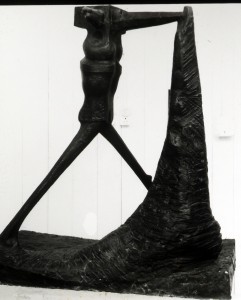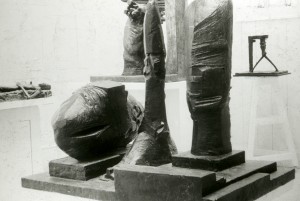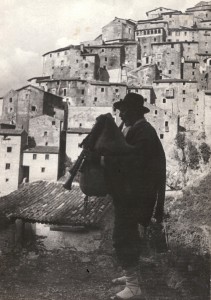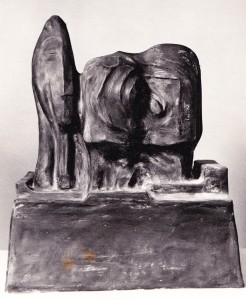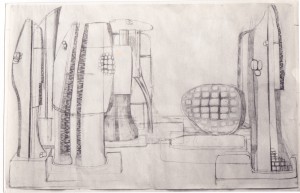My road to Rome went like this. I’d worked next to John Clinch, in our studio at the Royal College of Art, for almost three years. Approaching our final year we both made an application for the Rome Scholarship in Sculpture, more grandly known as the Prix de Rome. At the time I had only vague notions of what a year at the British School would entail. Clinch withdrew from the competition when his wife Christine became pregnant again, yet when my wife became pregnant for the second time I held fast and carried on regardless. With John no longer a candidate and Bernard Meadows a member of the selection panel, it seemed to me that this was my chance for glory.
With John Clinch’s help I carried Abraham, my walking man sculpture, fairly easily up the steps of the Commonwealth Institute in South Kensington where the judging was to take place. It was a cast in Ciment Fondu and, for the most part, hollow; it wasn’t heavy. Nearing the entrance we overtook a group of students from Wolverhampton struggling with a much weightier sculpture by Glynn Wiliams – a stone carving that was spherical with panels of relief. Although the odds were in my favour, I was bowled over to hear from Meadows that I been given First Prize. Glynn was runner-up as the Gulbenkian Rome Scholar. My last year as a student at the RCA was a success and not at all like my first. My studio space was filled with bronzed and polished figurative sculptures informed by Giacommetti, Richier and the British Group known by the phrase Anxiety of Fear. All set for a handsome Degree Show comprising dark work reflecting the pervading pessimism and disquiet of that time (before the Swinging Sixties got under way). After all, it was at the beginning of 1961 and many of us believed that nuclear missiles would drastically shorten our lifetimes. I was convinced that my son Christopher, then a baby, would never reach manhood. I remember going to a lecture given by a poet of the day, in which he talked about the ‘imminent destruction’ of every painting, sculpture, book, art gallery, museum, cathedral, theatre and so on: this was a very depressing scenario.
Always curious, David Sylvester asked those of us at the RCA who were about to graduate: what were our prospects when we left college for the real world? I had been a student for eight years, while others in the group had undertaken National Service between their two four-year courses. In order to carry on making sculpture I had to go to Rome for a year. Others would begin their teaching careers of a day here and a day there. They would probably buy a second hand car and drive to Art Schools up and down the country for a day’s pay.
Prof Bernard Meadows had advised me that if I was to have a good chance of securing the Sir James Knott Scholarship, I “needed to make another large work,” a sentence that was typically the extent of his tutorials. This prize, administered by the RCA, was awarded annually to Painting and Sculpture graduates who came from the North of England. I did make another large work but evidently not big enough, as in the event I shared the £300 with Olive Goldsmith, a painter who was also from Sunderland and a woman who I found very attractive. At a party, I was doing my best to commit adultery with Olive, as a way of celebrating our scholarship success, when Alan Price intervened. I never thanked him for that.
I had planned to go to Italy on my own but after some domestic turbulence, my wife, Christopher (at eighteen months) and newly born Alison (of three weeks) set out from Newcastle to Heathrow. Once there we were hurried across the tarmac – women and children first – boarding an Alitalia Caravelle and making our way across the Alps, to the Eternal City. Going through customs at Fiumicino airport, the officer examined my small collection of sculptor’s tools. He looked at me. “Come Michelangelo,” he said, and smiled. I had arrived in sculptor’s heaven! However, my welcome at the British School was less openhearted, turning up with my family was an unwelcome surprise. My allotted studio with its single balcony bed was inadequate for two adults and two babies and within 24 hours we were driven by Medd, (a kind man, in some way associated with the British School) out of the city via Tivoli to Anticoli. Anticoli Corrado is a municipality located about 40km northeast of Rome. Only about one thousand residents live there all the year round. Anticoli became known in the nineteenth century because some of its younger inhabitants posed as models for the community of artists living near the Piazza di Spagna in Rome. Some of these artists eventually went to see the birthplace of their models and found Anticoli a very picturesque place, to the point of living there for some time. The village has always attracted British artists: Kenneth Armitage and Ann Tremain, Irena Hale-White, Ken Lee, Hans Inlander, Peter Freeth and Glynn Williams were all artists known to me who were associated with Anticoli. I had exchanged the confinement of the British School for the independence of rural life among the olive groves.
My plan was to work for the first year of my two year scholarship and travel in the second, the reverse of my original intention. I had brought my responsibilities with me and I had to make the best of it. At 18 via San Rocco I began work by covering the walls of one of the bedrooms that was used as my workspace, with taped together strips of wallpaper. I made three very large drawings as ‘Palace Garden’, following on from the work in my Degree Show and indicating the direction of the new sculpture to be made in Italy. Working in clay for plaster throughout that year, I made a number of unremarkable sculptures. Only one of these I wish I had with me now: Three Heads on a Plinth. For recreation I played Tiddly Winks. At Christmas time I had bought a game in a toyshop in Tivoli. For a while Ken Lee and I played best of 101 games almost every night. We became remarkably skilful! If I had applied that same diligence and serious practice to any other pursuit I might be fluent in Italian or good at chess or a better sculptor, instead of just being very adept at Tiddly Winks. Our house was the last in the village, a new build and the house furthest up the hillside, almost among olive trees. Built as a summer residence, it was relatively cheap because I’d rented it for a year. The views were good but my lasting impression is that during the months we were there, September until early June, it was a cold place. The gas Bombola sent out only a local heat. The marble floors could be icy cold but they were easy to clean, to wash the clay and plaster off the tiles in the bedroom that I used as a ‘studio’.
I have happier memories of the village cuisine; pizza cooked in the communal oven, and at Christmas it was the place to roast our chicken. When we were invited to eat with our neighbours, the Muzzi’s, there was Polenta poured straight into the centre of the scrubbed pine table – the family and guests began to eat their way towards the spicy sausages covered with an oily tomato gravy, that were huddling together in the middle of the yellow maize.
Among the weekend visitors from the British School, in Rome, on a day trip to see the Scholars – Peter Freeth, (printmaker), Ken Lee (painter) and myself, was Sir William Coldstream. At that time he was taking a break from the National Advisory Council on Art Education. He had recently published the Coldstream Report for a new Diploma in Art and Design, one that put Art first. The local shopkeepers in Anticoli, seeing Coldstream and Monica walk up the hill, were very impressed that an English ‘Lord’ and his beautiful wife should visit me. My credit rating in Anticoli soared!
When introduced my children, however, both visitors discerned that Alison was not as she should be. William gave Monica, a mother-to-be, a reassuring squeeze. Not until later did I fully understand this action – I thought it had been merely a charming and spontaneous gesture of affection. Soon after this occurrence, I returned to the house and came upon my wife in the bedroom. She was holding Alison before the wardrobe mirror, looking carefully at the baby’s reflection. I could see that Alison’s mirror image showed a face that was not quite right. The certainty that nothing could be amiss with a child of mine quickly ebbed away and through the looking glass foreboding loomed. I took Alison to the Dottore. He had his breakfast most days at the Trattoria in the piazza. After he had examined Alison, he pressed me to take her to Rome to be seen by a paediatrician. Very early in the morning the bus, a blue Zeppieri, picked up passengers where the meandering road down from the village met the main highway to Rome. It was a long walk carrying Alison in the dark and the chilly air. The ride took more than an hour as the day lightened into summer. At this historical distance, I cannot recall exactly what I was thinking, but I remember my resolve about being strong for my daughter. I must have presented an unusual sight on that journey. A young Englishman carrying a baby, wrapped tight in a white woollen shawl; walking the two miles to board the bus. Then on the bus, surrounded by the curious stares of men going to work and women going to market. Finally walking through the streets of Rome to Bambino Gesu Ospedale Pediatrico. I waited on a wooden bench in a high ceilinged room, more like a chapel than a hospital. I had been given a number on a piece of card, not more than a inch square: 21. It was written in ink and I still have it.
The examination and the consultation were short. The paediatrician was in no doubt that Alison was a ‘Mongol’ child. I was advised to return to England as quickly as possible as ‘these babies are better looked after there’. I was very sad on the journey back to Anticoli. Stunned with anxiety, I cried as we climbed the winding road to the village, back to my wife and son and our very temporary home. At the house I cried even more. Somewhere among the turmoil of emotions that followed my arrival home was the intimation that although I was, as ever, determined that we would all manage, after such a day as that, matters between my wife and myself would never be the same. I loved and cherished Alison, I had spent a long day with her, out in an unfamiliar world. I had nourished her and held her close, and I was not ashamed of her.
We returned to London staying with John Clinch and Christine. Their doctor advised me to put Alison in a home. The implication being that we were too young and inexperienced to deal with the difficulties of raising a Down Syndrome child. Moving to Neston, near Corsham, we resisted this suggestion for some time. However finally, I had to admit that we could not manage. We both coped badly with that second look, the ‘Oh-dear-what-a-pity’ look, whenever we went out with Alison. Eventually, apart from work and shopping at the handy store across the road, we could not face other people. Feeling guilty in this way had annulled my wife’s love for Alison and I called out to Special Services for help. They responded very quickly and saved the day. My wife nearing a breakdown, I took Alison on another journey, to a Care Home in Mells, near Frome in Somerset. I carried Alison through wards of disabled children and babies and handed her to a carer. I wanted to take her back and return home with her, knowing that my wife would never come to such a place to visit her daughter. But I could not. The wellbeing of Christopher and his mother needed to be considered. I left her there and shortly afterwards, she died of pneumonia. The hole in her heart had made her vulnerable. Less than three weeks later I was again in Mells, this time to collect Alison in a tiny white coffin. I carried her again, on a cold and icy February day, to an unmarked grave in Ladbroke Lane cemetery near Corsham.
At lunchtime on working days, I’d cycle to the cemetery to visit Alison’s grave, to say sorry for my uncertainties and to thank her for her smiles and laughter. Alison was, above all, a loving child. But too soon this practice faded. We moved from Neston to Corsham and the traces of Alison were left behind. Our new home was a rented house in Pound Pill, belonging to the Methuen Estate, a place where Alison had not resided and therefore was not often mentioned.
